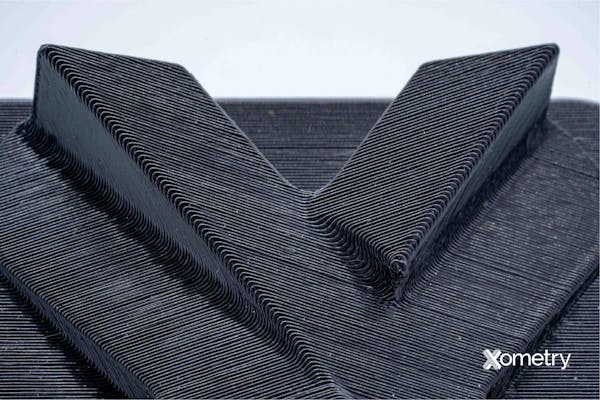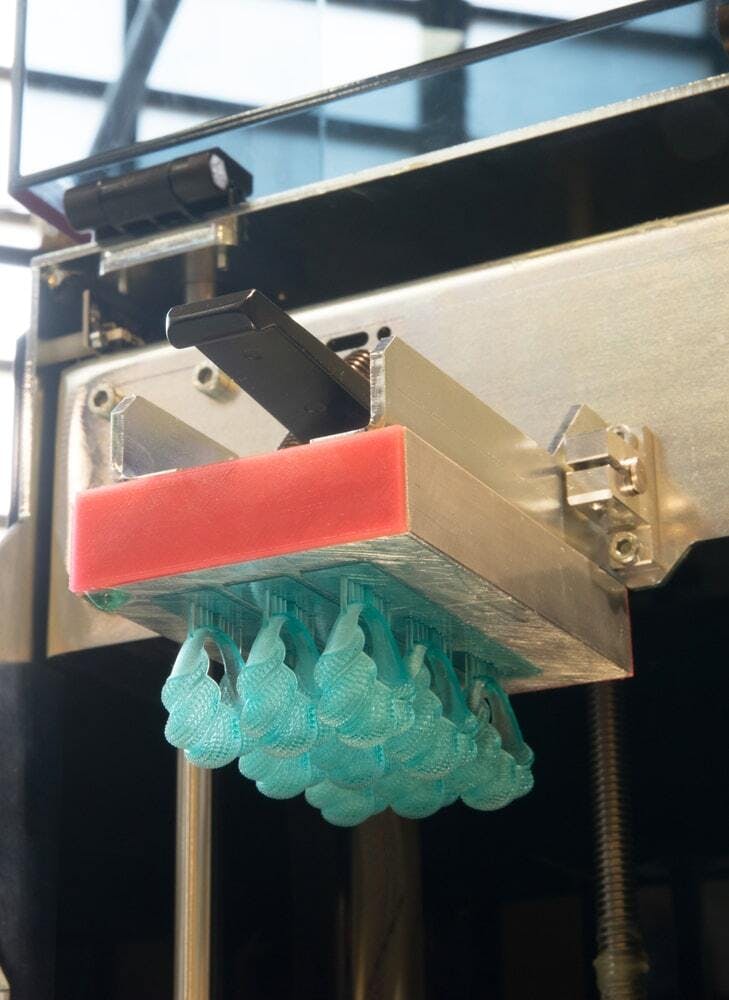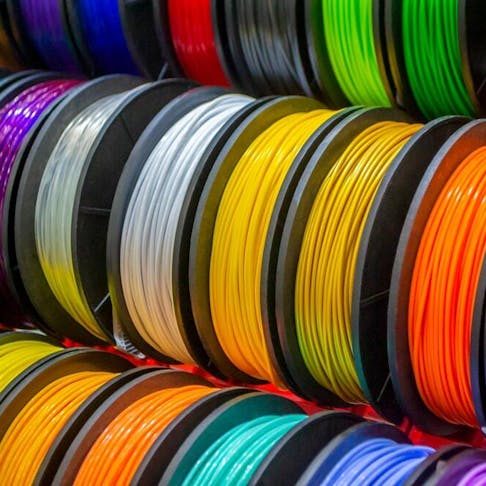Fused Deposition Modeling (FDM) is a 3D printing technology that builds parts by extruding a melted plastic filament onto the build plate one layer at a time. Digital Light Processing (DLP), on the other hand, creates parts by polymerizing a liquid photopolymer resin by projecting a single UV light image of the part cross-section onto the build plate. DLP produces isotropic parts with very high levels of surface detail and resolution. It can also produce parts extremely quickly. FDM printers are cheaper than DLP printers and have a wider range of materials available. Xometry offers instant quotes on FDM 3D printing, but does not yet offer DLP.
This article will compare FDM vs. DLP in terms of their differences, materials, and printing technology.
FDM Introduction and Comparison to DLP
Fused deposition modeling is the most well-known 3D printing technology. It was first developed by Scott Crump in 1988 who later commercialized the first FDM printer. The process is relatively simple. It involves guiding a thin filament of thermoplastic through a heated nozzle/hot end. The plastic exits the nozzle and is placed on the build plate in the pattern of the part cross-section. Once a layer is complete the print nozzle moves up one layer and deposits the plastic on the previous layer until the part is complete.
FDM is a simpler technology when compared to DLP. This makes it significantly cheaper for hobbyists. There are many different rigid thermoplastics and even flexible thermoplastic polyurethanes available. A typical FDM printer is shown below:
To learn more, see our guide on What is FDM or visit our FDM 3D printing service page.

Advantages and Disadvantages of FDM Compared to DLP
Listed below are some key advantages of FDM vs. DLP:
- FDM printers are significantly cheaper than DLP 3D printers
- FDM has a wider range of material colors. Parts can also be made to be significantly stronger than those made with DLP printers.
- FDM printers can produce larger prints when compared to DLP printers
Listed below are some key disadvantages of FDM vs. DLP:
- FDM has a poor surface finish and cannot produce very fine features
- FDM parts have a high level of anisotropy in the z-direction. This is due to the poor interlayer bonding strength common with FDM parts.
DLP Introduction and Comparison to FDM
Digital light processing was invented in 1987 by Texas Instruments. This photopolymer-based 3D printing technology works by projecting a UV light onto the build platform to polymerize each layer of the part. The layer cross-section needs to be masked so that only the required areas are polymerized. This masking is done with a DMD (Digital Micromirror Device). The DMD uses a micromirror to either direct the light to the photopolymer or direct it to a heat sink below. Alternatively, LED screens can be used as a light source. The masking is done by simply turning off the LEDs wherever polymerization is not required. The resolution of a DLP 3D printer depends on the resolution of the LED or DMD array as well as the distance from the light source to the polymerization zone. DLP parts are made up of cubic volumes called voxels. This means any curved edges look as if they were built from many smaller cubes.
DLP printers are more expensive than FDM printers. They also have smaller build volumes and fewer material options but can print faster at much higher resolution and surface quality. A typical DLP printer is shown in the image below:
To learn more, see our guide on DLP 3D Printing.

A typical DLP printer.
Image Credit: Shutterstock.com/Moreno Soppelsa
Advantages and Disadvantages of DLP Compared to FDM
Listed below are some key advantages of DLP vs. FDM:
- DLP printers can produce parts with very small features and high resolution
- DLP parts are isotropic. This means the mechanical properties are the same regardless of the direction of the applied load.
- DLP can print extremely quickly. It can also print multiples of a part at the same time it takes to print one
Here are some key disadvantages of DLP vs. FDM:
- DLP printers are generally more expensive than FDM printers
- DLP parts require additional post-processing steps like solvent rinsing and UV light post-curing
- DLP printers have much smaller build volumes when compared to FDM printers
| Attribute | DLP | FDM |
|---|---|---|
Attribute Print resolution | DLP 25 to 300 Microns | FDM 50 to 500 Microns |
Attribute Can print large parts | DLP No | FDM Yes |
Attribute Wide range of material colors | DLP No | FDM Yes |
Attribute Minimum feature size | DLP 100 Micron | FDM 1 mm |
Attribute Can produce high-strength parts | DLP No | FDM Yes |
Attribute Has isotropic material properties | DLP Yes | FDM No |
Attribute Minimum wall thickness | DLP 0.1 to 0.3 mm | FDM 1 mm |
Attribute Parts need support structures | DLP Yes | FDM Yes |
Attribute Largest print volume | DLP 192 x 108 x 370 mm | FDM 1000 x 1000 x 1000 mm |
Table. FDM vs. DLP Comparison
Other Key Comparisons
Technology comparison: FDM and DLP have completely different technologies and materials and are not directly comparable. FDM uses a thermoplastic filament that gets heated and extruded layer by layer to produce a part. A DLP printer, on the other hand, polymerizes a liquid photopolymer resin with a UV light layer by layer to produce a part.
Material comparison: FDM makes use of a wide range of rigid thermoplastic materials as well as flexible thermoplastic polyurethane. Specialized filled filaments are also available to further improve part strength. DLP printers also have access to both rigid and flexible photopolymers, however, colors are limited.
Applications comparison: FDM parts exhibit higher strength and toughness. They are usually made for more mechanically inclined applications like assembly jigs, functional components like brackets, or functional prototypes. The high visual fidelity of DLP printers makes them better suited for finely detailed applications. This includes patterns for casting jewelry and visual prototypes of fine-featured products.
Print volume comparison: FDM printers have significantly larger build volumes when compared to DLP printers. FDM printers can reach sizes of up to a cubic meter. DLP printers on the other hand have smaller build volumes. This is due to some limitations in the underlying UV projection technology. DLP printers are limited by the resolution of the projecting screen and the distance from the light source to the polymerization zone.
Surface finish comparison: DLP parts have significantly better surface finishes when compared to FDM printers. DLP parts look injection molded and only have a loss of fidelity on complex organic surfaces or features. This is due to DLP printers not being able to create true curves but rather approximate curves using cubic voxels.
Cost comparison: FDM printers are significantly cheaper than DLP printers due to the much simpler technology employed. An entry-level FDM printer can cost as little as $150 whereas an entry-level DLP printer can cost $500. It must be noted that the cost of DLP printers has been steadily falling in recent years. FDM parts from Xometry are usually among our most cost-effective.
Summary
Xometry provides a wide range of manufacturing capabilities including online 3D printing, CNC machining, injection molding, laser cutting, and sheet metal fabrication. Get your instant quote today.
Disclaimer
The content appearing on this webpage is for informational purposes only. Xometry makes no representation or warranty of any kind, be it expressed or implied, as to the accuracy, completeness, or validity of the information. Any performance parameters, geometric tolerances, specific design features, quality and types of materials, or processes should not be inferred to represent what will be delivered by third-party suppliers or manufacturers through Xometry’s network. Buyers seeking quotes for parts are responsible for defining the specific requirements for those parts. Please refer to our terms and conditions for more information.


